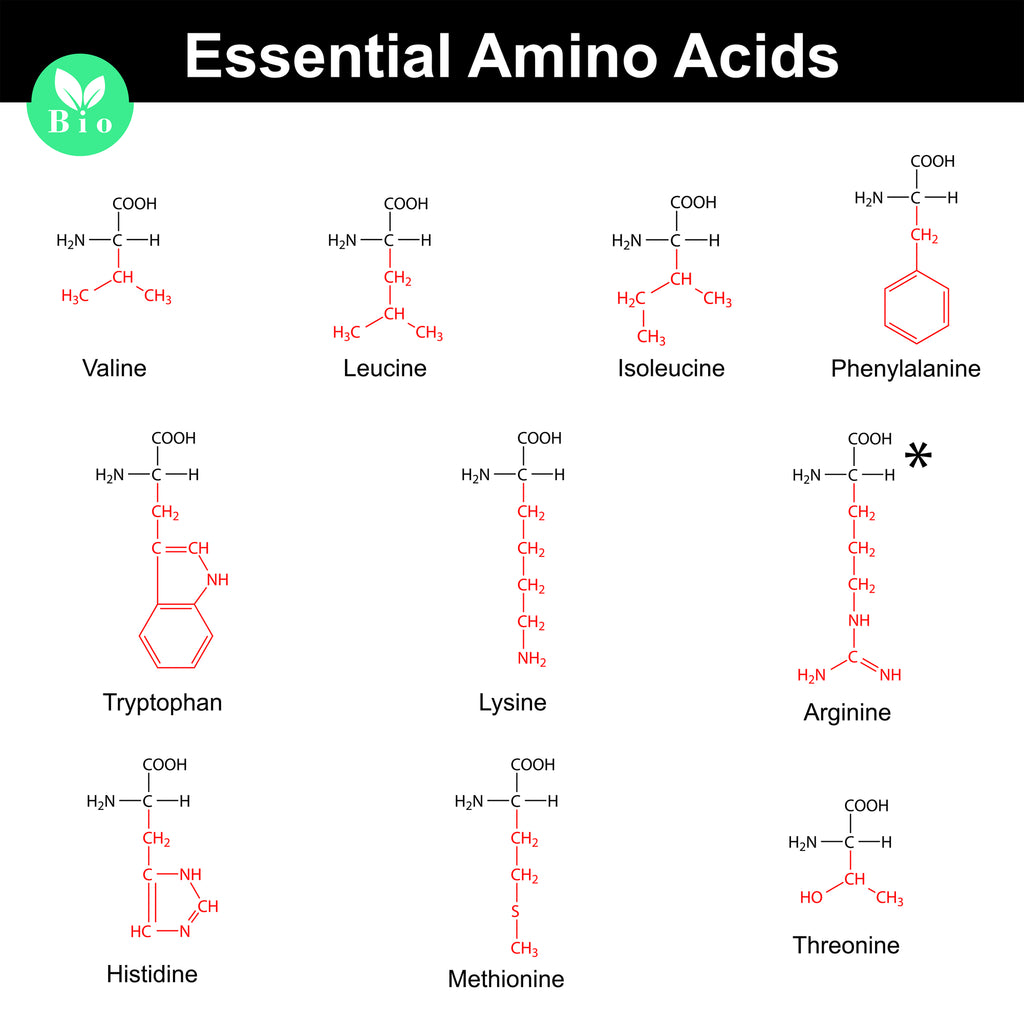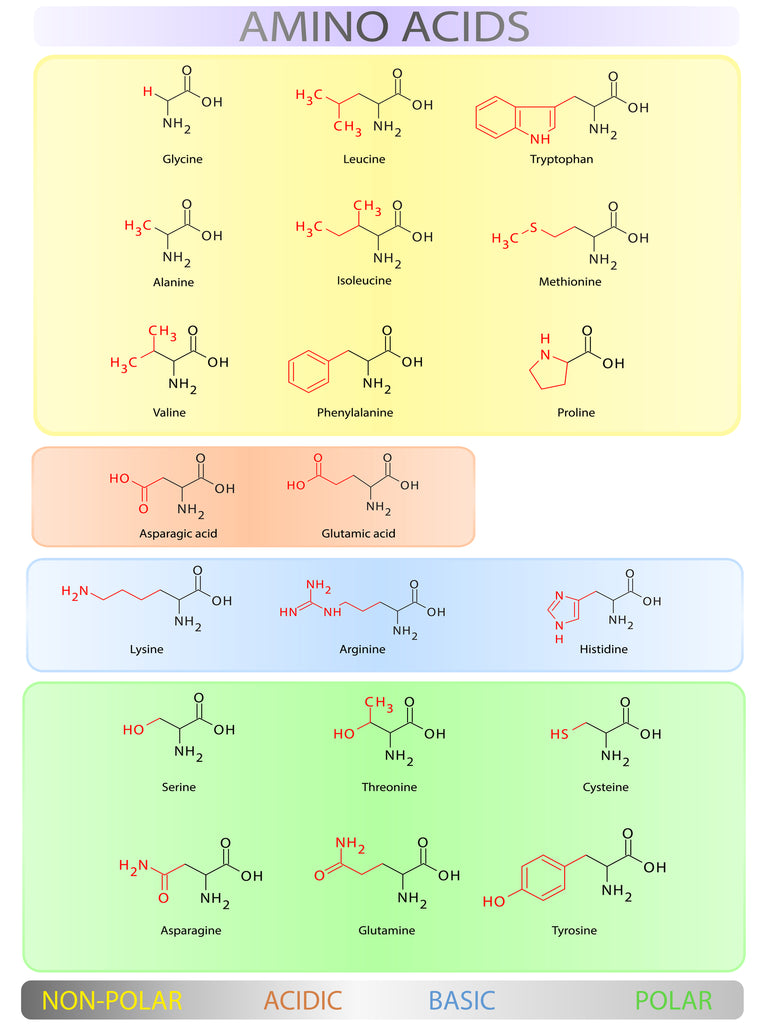EAAs vs. BCAAs: Which Amino Acid Supplement Is Best for Your Health, Energy, and Muscles
This article sets the record straight on EAA’s vs BCAA’s, and the science behind how they make your muscles bigger, power you through the toughest workouts, and optimize your health at home.
Science has proven that they speed up your gains, making you bigger and stronger faster. So why all the arguing? Truth is, if you aren’t doing things right, you’re wasting your money and wasting time in the gym.
Here’s everything you need to know…. (and why we settled on making a CLEAN EAA product without all the weird artificial fillers and sweeteners)
EAAs and BCAAs: Why Does All This Matter for Your Muscles?

If you’re trying to build bigger muscles at the gym and reach your peak, you need the proper nutrients to repair the damage done during training or you’ll never grow.
All that grunting, sweating, and making it seem like the weight is way heavier than it really is when girls walk by tears your muscles apart, and you need nutrients to rebuild them better than they were before. That’s where EAA’s and BCAA’s come in. These fast-acting supplements provide an energy boost and help build lean muscle.
OK, so now you’re probably wondering: DO I TAKE EAA’s OR BCAA’s TO LOOK LIKE THE ROCK IN 3 WEEKS?
The answer is... well... both.. kind of... depends.
In this guide, we’ll cover:
But first, let’s cover what amino acids are….
What Are Amino Acids?
You know protein, that nutrient responsible for your bulging muscles, thumping heart, and super genius brain? Amino acids are the building blocks of that nutrient. They are absolutely essential to life. Without them, you couldn’t think, talk, write, or lift anything.
When you smash a protein shake before a workout or engulf a second steak and bean burrito (To the horror of Taco Bell’s late shift cashier), the protein is broken down into 20 different amino acids. Your body can produce the majority of them on its own. However, there are 9 that have to be obtained elsewhere (more on that below).
Each one has a unique function, and they’re responsible for everything from building muscles and bones to helping your body fight off invaders. All living things are composed of proteins and all proteins are composed of chains of amino acids.
They’re pretty important.
METAPHOR!: Amino acids are the alphabet of proteins: Think of proteins as the words that make up the book of your body. Your body (the book) is made up of words (proteins), but in order to create these words you need an alphabet. Amino acids are that alphabet!
What Are EAA’s (Essential Amino Acids)

Essential amino acids, or EAA’s, are a fellowship of 9 amino acids that your body can’t produce enough of on its own but are vital to protein synthesis, tissue repair, and nutrient absorption.
Your only choice is to get them through food (or taking an EAA supplement *wink wink*).
The 9 essential amino acids are:
EAA’s are at the core of many of your body’s most vital functions. But 3, in particular, are vital to big muscles and your dream of a cheese-grater core (FORESHADOWING):
- Leucine helps repair muscles so you can recover faster and grow bigger [1].
- Isoleucine is heavily concentrated in your muscles and vital for regulating energy [2].
- Valine is a stimulant with a major effect on making your muscles bigger and tissue more durable [3].
Much more on these 3 in a second….
OK, cool. EAA’s sound AWESOME. So why is there a big debate about EAA’s vs BCAA’s? Which one is better?
Here’s the plot twist…
BCAA’s and EAA’s are the same things.
… It’s true.
WHAT!?
BCAA’s ARE EAA’s?!
To be more specific, they’re a subgroup of EAA’s. Remember those 3 we just mentioned that were vital to your gym gains? Those are the BCAA’s!
So, all BCAA’s are EAA’s, but not all EAA’s are BCAA’s… hope that’s making sense.
What Are BCAA’s?
Branched-chain amino acids, or BCAA’s, are the subgroup of EAA’s named after a branch coming off their chain. 3 of the Fellowship of 9 fall into this category: valine, leucine, and isoleucine.
They have a major impact on muscle growth and energy production, especially during and quickly after exercise. Of the 9, these are by far the most abundant and effective.
BCAA’s comprise up to 40% of all essential amino acids in your body [4]. That means if you’re trying to grow in the gym, BCAA’s are going to be what makes the difference between gains and GAINZ.
Taking BCAA’s immediately after exercise has proven to increase muscle protein synthesis by 22% [5]. Your muscles are especially receptive to extra BCAA’s post-exercise (up to 48 hours after). Hence why they’re all the rage these days. They can even help reduce fatigue and help you train longer [6].
Wow, OK. So BCAA’s are the EAA’s that will make me look like The Rock, so there’s no point in taking EAA’s right?
WRONG.
In fact, it’s actually the opposite.
EAA’s are going to make you like The Rock, and BCAA’s are just one part of the equation. Albeit a very important one.
It’s simple biology:
WITHOUT ALL 9 EAA’s YOUR BODY CANNOT BUILD PROTEINS!
Sure, the BCAA’s might be the most powerful, but if you don’t have all 9, you aren’t getting big muscles. It’s just logic.
9 essential amino acids = protein.
Protein = big muscles.
Therefore…
9 essential amino acids = big muscles.
If you take BCAA’s, you’re only getting 3 out of the 9. Your body will start frantically looking for the other 6 like a fiend.
See why you should take EAA’s instead?
If you take EAA’s, you’re getting BCAA’s PLUS the other 6 that you need to make protein.
Are EAA’s Better Than BCAA’s?
In general, yes. Ever since we found the optimal blend of EAA’s and started taking it regularly, we’ve noticed far better results in the gym, especially when it comes to recovery. Taking EAA’s gives you all of the amino acids you need to build big muscles plus other vital amino acids you need for regulating dopamine function, boosting your immune system, promoting healthy blood sugar levels, and supporting heart health.
So does that mean BCAA’s are worthless?
No, not quite.
BCAA’s can still have a positive effect on your workout, but you need to be eating right in order to get the gainz. In a perfect world, you’d get all of your amino acids from chewing dead animals like chicken and cows. Thing is, it’s EXTREMELY difficult to meet your daily requirements, especially when you’re training like a beast.
If you’re getting the right level of protein from your diet (about 1.4 g per KG of body weight), then BCAA’s will be fine since you’re getting the other amino acids from your diet.
If you’re not (and we struggled with this mighty), then BCAA’s won’t help you.
TL;DR: BCAA’s are great, but if you don’t have all 9 essential amino acids, you aren’t getting cannons on your arms any time soon (and may feel a bit worse if just taking only BCAA's). If you’re getting the recommended protein intake, then BCAA’s will be just fine. If you're not, you need EAA’s instead. Either way, EAA’s are a more comprehensive solution.
The Easiest Way to Get Enough EAA’s to Build Muscle and Burn Fat
We struggled to get enough EAA’s every day. It’s NOT EASY.
After months of seeing nowhere near the results we expected, we realized our diet and supplementation just wasn’t cutting it.
We weren’t getting the results we wanted because we weren’t getting the right balance of EAA’s. We were taking BCAA’s right after working out and seeing nothing.
With the proper blend of each essential amino acid needed for muscle growth, energy, and cognitive function, we were able to have longer, more productive sessions at the gym with better muscle recovery after.
If you’re struggling to get results, then you have to try this blend of EAA’s. It’s the optimal blend of all the muscle-building amino acids your body needs to stop fitting through doors without turning sideways.
This blend has made a HUGE (pun intended) difference for us.
-
BCAA 2:1:1 - 3150 mg (L-Leucine, L-Isoleucine, L-valine): Athletes are crazy about BCAA’s. These 3 amino acids go straight to your muscles, helping you building muscle faster and train longer. BCAAs are proven to help you train longer [7], recover faster [8], and build those guns [9].
- L Lysine -750 mg: For maximum absorption. Lysine helps build muscles by producing carnitine and aiding calcium absorption.
- L Phenylalanine - 600 mg: The 600 mg mega dose pumps your system full of the amino acid that gets converted to tyrosine and is used in the biosynthesis of dopamine.
- L Threonine - 500 mg: For weight management. L-threonine is an amino acid responsible for fat metabolism.
- L Histidine - 250 mg: Give your body the raw materials it needs to create histamine, a powerful cognitive neurotransmitter and the key to regulating your immune and inflammatory responses.
- L Methionine - 150 mg: Empowers your cells to work harder and longer. L-methionine has powerful anti-aging [10] and cellular-protective benefits.
- L Tryptophan - 50 mg: The direct precursor of serotonin, this dosage of tryptophan is the perfect amount to help regulate your appetite, sleep, and mood.
References
[1] https://pubchem.ncbi.nlm.nih.gov/compound/L-leucine
[2] https://pubchem.ncbi.nlm.nih.gov/compound/l-isoleucine
[3] https://pubchem.ncbi.nlm.nih.gov/compound/L-valine
[4] https://pubchem.ncbi.nlm.nih.gov/compound/l-isoleucine
[5] https://www.ncbi.nlm.nih.gov/pmc/articles/PMC5461297/
[6] https://www.ncbi.nlm.nih.gov/pubmed/16424144
[7] https://www.ncbi.nlm.nih.gov/pubmed/21297567
[8] https://www.ncbi.nlm.nih.gov/pubmed/20601741
[9] https://www.ncbi.nlm.nih.gov/pubmed/28638350
Updated January 25, 2020